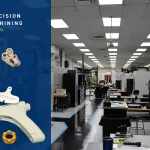The continuous service temperature, or continuous use temperature (CUT), is the maximum ambient service temperature in air that a material can withstand and maintain 50% of its initial physical properties after long-term service.
What is long-term service? It’s defined as 100,000 hours of service – well over 11 years, if used 24 hours a day, 365 days a year. The continuous use temperature property tells machinists and users what will happen to a part over the course of roughly 11 years of continuous use. It’s the temperature at which the polymer will degrade, embrittle and start to break down.
It is important for the designers, engineers and users to take this measurement into consideration for CNC machining. During the design phase, this not only helps with initial material selection, but plays a role in predicting the life span of a part. At AIP, we take great care in providing unrivaled results to ensure the optimal dimensions and properties for machined polymers and composites. Join us in this technical brief as we give an in-depth explanation of the continuous use temperature for machined polymers.
What Affects Continuous Use Temperature?
The base material polymer structure affects the continuous use temperature of a machined part. The time that is involved and the loading levels that are used in the testing can affect the CUT value. Also, additives and reinforcements should be taken into consideration. They may have an effect on the maximum continuous use temperature value.
Tests to Measure Continuous Use Temperature of Plastics
The continuous use temperature is measured in degrees Celsius (o C) or Fahrenheit (o F). One of the common tests used to compare different materials in terms of continuous use temperature is the Underwriter Laboratory (UL) Relative Thermal Index or RTI.
UL 746B
This test method is used to determine RTI values. The RTI is based on a loss of properties of the plastic versus time. In general, when the plastic is exposed to this maximum continuous use temperature – good, long-term performance is observed. However, it does not consider short-term thermal spikes.
RTI gives an indication of the aging temperature that a material can endure for 100,000 hours and still retain at least half of the initial property being measured. However, different properties for materials decay at dissimilar rates. This is the primary reason why often RTI values are associated with a particular property and the related CUTs are given as a range of values rather than as a single value.
Determination of RTI Value
- Groups of test pieces are placed in ovens at four different pre-set temperatures.
- At specified time intervals, the test pieces are taken out of the ovens and tested for mechanical and electrical properties of interest.
- The results are plotted on a property versus time graph until the property that is being tested declines to 50 percent or less of its initial value.
In this analysis, the 50 percent value of the property is referred to as the half-life of that particular property. The half-life values are then, plotted against the reciprocal of the absolute aging temperature. This plot results in a straight line that can be extrapolated, if needed, to indicate the half-life of the property at other temperatures.
The results that are obtained in this testing procedure can also be compared to a material with a known aging performance.
Types of RTI
There are three general classes of properties that are associated with the RTI. The three values for a particular polymer are often different from each other. They are the following:
- The RTI Electrical that is associated with insulating properties.
- The RTI Mechanical Impact which is related to the impact resistance, toughness, elongation and flexibility.
- And, the RTI Mechanical Strength that is associated with the mechanical properties or the structural integrity of the plastics.
Continuous Use Temperature Values for Common Polymers
| Polymer Name | Min Value (o C) | Max Value (o C) |
| ABS – Acrylonitrile butadiene styrene | -20 | 80 |
| PA – Nylon Polyamide, 66 30% Glass Fiber | 100 | 150 |
| PAI – Polyamide-Imides (TORLON) | -196 | 220-280 |
| PBI – Polybenzimidazole (CELAZOLE) | 204 | 540 |
| PC – Polycarbonate, high heat | 100 | 140 |
| PE – Polyethylene, 30% glass fiber | 100 | 130 |
| PEEK – Polyetheretherketone | 154 | 260 |
| PEI – Polyetherimide (ULTEM) | 170 | 170 |
| PP – Polypropylene | 100 | 130 |
| PS – Polystyrene, high heat | 75 | 90 |
| PSU – Polysulfone | 150 | 180 |
| PTFE – Polytetrafluorethylene | – | 260 |
| PVC – Polyvinyl chloride, rigid | 50 | 80 |
| PVDF – Polyvinylidene fluoride (KYNAR) | – | 149 |
Continuous use Temperature Does Not Define Polymer Strength
It is important to note that the continuous use temperature does not define a part’s ability to handle a load under a specific temperature. One material that proves this is PTFE. PTFE is an advanced thermoplastic that can handle 500 o F continuous service without breakdown. Yet, it is a soft material, which bends easily at room temperature. This property is called the heat deflection temperature (HDT), which is another important property to consider.
AIP: Unrivaled Precision Machining
Data charts can give you the Continuous Use Temperature, glass transition and other values. However, a chart can give a general idea of these values, but an entire data set with the curve of a material is the best way to determine the right material for your project.
Be sure to work with a plastics machining company that can provide you a wide range of data on the CUT of polymers and composites. Your sales engineer will be able to give you a detailed response on how the continuous use temperature will affect your project’s design and functionality. Talk to one our engineers at AIP about your project design, and we will work with you to provide unrivaled expertise from your project’s initial concept to completion.
Supportive Information
Certifications and Regulatory Resources
Our team is dedicated to providing unparalleled, quality machined polymers and composites. Learn more about the material properties we consider when working on a project.






